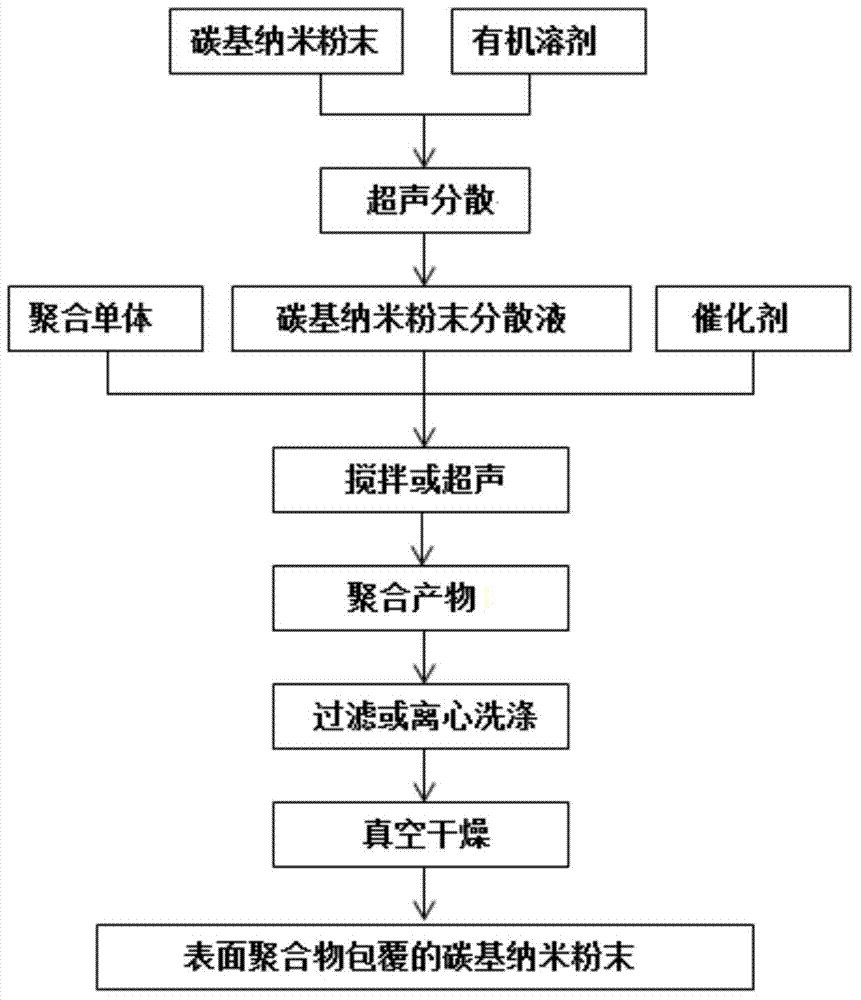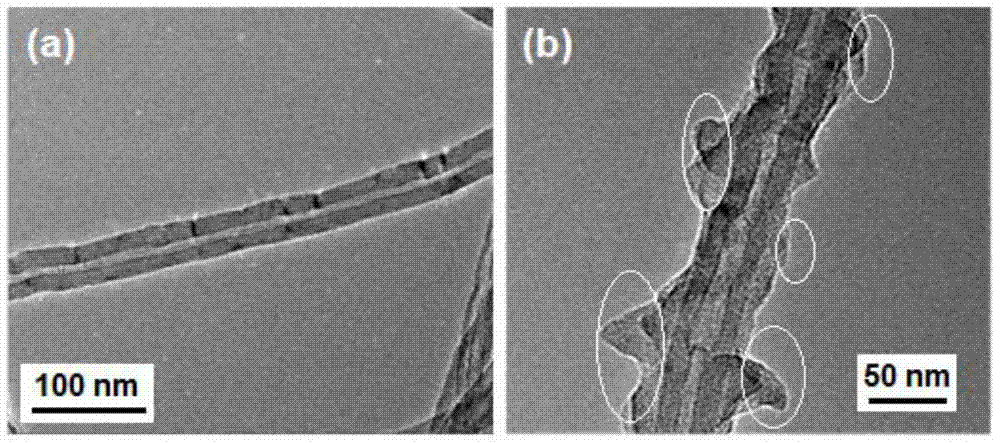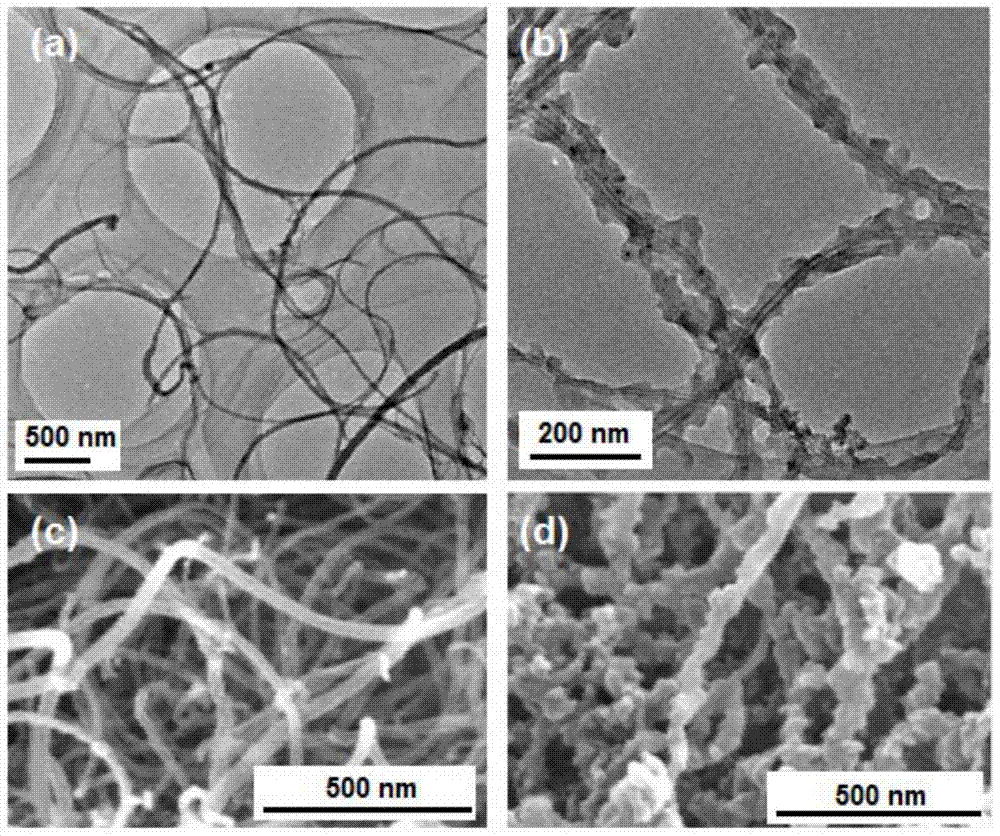Method for crystallizing and coating polymer on carbon-based nano material surface
A carbon-based nanomaterial and carbon-based nanopowder technology, which is applied in the field of non-covalent coating and modification of carbon-based nanomaterial surface polymers, can solve problems such as unfavorable large-scale application and harsh crystallization conditions, and achieve controllable product structure. , Wide range of application, the effect of maintaining stable structure
- Summary
- Abstract
- Description
- Claims
- Application Information
AI Technical Summary
Problems solved by technology
Method used
Image
Examples
Embodiment 1
[0044] Embodiment 1, comparative example 1
[0045] 1. Sample preparation
[0046] (1) Embodiment 1
[0047] Step 1: Under nitrogen protection, 150mg (feeding concentration: 5mg / mL) multi-armed carbon nanotubes (MWCNTs, product of Chengdu Institute of Organic Chemistry, Chinese Academy of Sciences, with a purity of 95%, an average outer diameter of about 30nm, an average inner diameter of about 10nm, and an average Length 30~50μm, specific surface area 233m 2 / g) and 24mL of anhydrous dichloromethane were added into a 50mL Schlenk reaction bottle, and the initial dispersion of MWCNTs was obtained by ultrasound (power 75W, time 2h) at room temperature; Bulk cyclopentene (4.76g, feeding concentration is 4.67×10 -4 mol / mg MWCNTs) and 50mg Pd-diimine catalyst 3 (feeding concentration is 3.2×10 -4 mmol / mg MWCNTs), then at a constant temperature (25°C) and magnetic stirring speed (200rpm), the reaction was continued for 8h to obtain a reaction product.
[0048] Step 2: centrifu...
Embodiment 2
[0055] Embodiment 2, comparative example 2
[0056] 1. Sample preparation
[0057] (1) Example 2
[0058] Step 1: Under nitrogen protection, 150mg (feeding concentration: 5mg / mL) multi-armed carbon nanotubes (MWCNTs, product of Chengdu Institute of Organic Chemistry, Chinese Academy of Sciences, with a purity of 95%, an average outer diameter of about 30nm, an average inner diameter of about 10nm, and an average Length 30~50μm, specific surface area 233m 2 / g) and 24mL of anhydrous dichloromethane were added into a 50mL Schlenk reaction bottle, and the initial dispersion of MWCNTs was obtained by ultrasound (power 75W, time 2h) at room temperature; Bulk cyclopentene (4.76g, feeding concentration is 4.67×10 -4 mol / mg MWCNTs) and 100mg Pd-diimine catalyst 3 (feeding concentration is 6.4×10 -4 mmol / mg MWCNTs), then at a constant temperature (25° C.) and magnetic stirring speed (200 rpm), the reaction was continued for 4 h to obtain a reaction product.
[0059] Step 2: centri...
Embodiment 3
[0069] Embodiment 3, comparative example 3
[0070] 1. Sample preparation
[0071] (1) Example 3
[0072] Step 1: Under nitrogen protection, 150mg (feeding concentration: 5mg / mL) multi-armed carbon nanotubes (MWCNTs, product of Chengdu Institute of Organic Chemistry, Chinese Academy of Sciences, with a purity of 95%, an average outer diameter of about 30nm, an average inner diameter of about 10nm, and an average Length 30~50μm, specific surface area 233m 2 / g) and 24mL of anhydrous dichloromethane were added into a 50mL Schlenk reaction bottle, and the initial dispersion of MWCNTs was obtained by ultrasound (power 75W, time 2h) at room temperature; Bulk cyclopentene (4.76g, feeding concentration is 4.67×10 -4 mol / mg MWCNTs) and 75mg Pd-diimine catalyst 3 (feeding concentration is 4.8×10 -4 mmol / mg MWCNTs), then at a constant temperature (25°C) and magnetic stirring speed (200rpm), the reaction was continued for 8h to obtain a reaction product.
[0073] Step 2: Centrifuge (...
PUM
| Property | Measurement | Unit |
|---|---|---|
| length | aaaaa | aaaaa |
| size | aaaaa | aaaaa |
| specific surface area | aaaaa | aaaaa |
Abstract
Description
Claims
Application Information
 Login to View More
Login to View More - R&D
- Intellectual Property
- Life Sciences
- Materials
- Tech Scout
- Unparalleled Data Quality
- Higher Quality Content
- 60% Fewer Hallucinations
Browse by: Latest US Patents, China's latest patents, Technical Efficacy Thesaurus, Application Domain, Technology Topic, Popular Technical Reports.
© 2025 PatSnap. All rights reserved.Legal|Privacy policy|Modern Slavery Act Transparency Statement|Sitemap|About US| Contact US: help@patsnap.com



